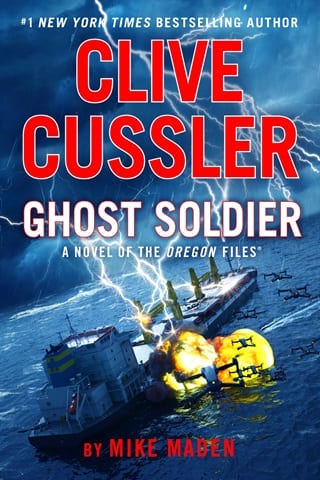Chapter 69
69
Pau Rangi Island
The Bismarck Sea
Shigeru Hashimoto, aka the Vendor, tugged on his beard as he studied the monitor. He had been tracking Mendoza and his team ever since they left their mother ship and made their way onto the island.
For once, he hadn’t underestimated the determined Mendoza or the considerable technical skills of that wretched vessel. Mendoza’s ship had not only changed its name to the Estacada, but also altered its paint scheme in short order, technologies that he deployed himself. But he had to hand it to the wily American for the presentation of the utterly believable illusion of the boat’s rust, wreck, and ruin.
Hashimoto was completely unsurprised when Mendoza deployed an electronic countermeasures device and disabled all of the island’s electronics.
By now Mendoza and his team had infiltrated the warehouse, and likely discovered the IED waiting for them there. Hashimoto blew air out of his nose, frustrated with the lack of imagery. He would have enjoyed nothing better than to witness the explosion and the slaughter the American swine.
Now he was blind to events on the ground.
No matter, he thought, as he pressed the button.
Mendoza would die just the same.
★Above Jaco Island
The Timor Sea
Hashimoto’s drone’s AI-driven navigation skillfully battled the turbulent storm winds several thousand feet above Jaco Island. It had been preprogrammed with the coordinates of the abandoned warehouse facility and was also locked on to the American GPS transmitter located inside.
Additionally, Hashimoto uploaded facial recognition software specifically targeting Mendoza, but as a final precaution he activated the optical “eyes-on” targeting system, anticipating the Estacada’s deployment of an EMP missile.
Once Hashimoto signaled the attack, the drone’s AI programming took over, and all of its sensors were fixed on the warehouse. It plunged through the chaotic winds in a wonky, twisted arc and at approximately ninety-one meters above the building all of its electronics ceased functioning.
But the warehouse was a fixed target and the drone’s onboard computer—which also ceased to function—had already made all of the necessary calculations to complete the final 3.3 seconds of the terminal phase of its mission. Deaf, dumb, and blind, the drone had transitioned from an independently guided weapon into a dumb bomb delivered with appalling accuracy.
★Aboard the Oregon
With Juan and Linda on the warehouse mission, Max was left in charge of the boat. The Gundogs’ comms were piped into the overhead speakers and the crew in the op center followed their movements with intense interest.
“Smart boy,” Max said in a half whisper when Cabrillo announced he was going to hit Murphy’s zapper and knock out all area electronics including their own comms. Better safe than sorry, he thought.
Like Juan, Max felt a great deal of unease at the fact there was no armed opposition on the island, and he fully agreed with Cabrillo’s suspicion that the Vendor would rely on a technological trap to catch them with their breeches askew. Besides, the lack of comms would only be temporary. As soon as Cabrillo deactivated the unit, the Gundogs would be back in touch and would make their exfil to the ship.
The Oregon’s photonics mast—a combination of glass and digital imaging—gave them a long-range view of the team as they exited the RHIB and made their way forward. Because it was a cloudy night with little ambient light, Max ordered Murph to deploy the mast’s infrared imagery. The op center crew watched the spectral figures on the big LCD wall panel up until the moment they melted away into the forest like an ancient folktale. Lightning flashes, brighter and increasing, lit the panel back up briefly before settling back down to a near perfect black.
Max turned in the Kirk Chair, his bloodshot eyes falling on the blackened LCD just as it flared into a massive white fireball.
★Above the Oregon
While Max and the op center crew were fixated on the Gundogs’ teeth-rattling race across the water and onto the beach, a swarm of drones—small, curiously shaped, and unarmed—hurtled through the tumultuous winds. They numbered in the thousands.
The lead elements alighted on the topmost sections of Oregon’s cranes, superstructure, and wire rigging. The rest remained airborne, functioning as leader strokes and streamers. Together, they formed a bridge of connectivity between the unimaginable energy boiling in the sky above and the massive steel frame of the ship.
The Vendor considered weaponized lightning, his most recent invention, the most terrifying weapon in his arsenal. A single lightning strike carried the equivalent energy of twenty-four hundred metric tons of TNT. A lightning storm delivered a relentless cascade of unfathomable power.
At precisely the right moment when the atmospheric conditions were perfectly aligned to the AI’s preprogrammed parameters, Hashimoto’s drones emitted a low-energy wave—just enough to attract and focus the first of dozens of lightning strikes against the Oregon’s hull. The resulting superheated air boomed like a relentless artillery barrage as lightning strikes burst in a rapid succession of blinding-white supernovas.
Each lightning bolt unleashed temperatures five times hotter than the surface of the sun. In the first strike, lines snapped, glass shattered, steel melted, and the crackling air sizzled with the chlorine tang of ozone and burnt metal. But even greater havoc fell on the ship as the lightning barrage escalated.
The Kashtan close-in weapons system and its missiles, housed atop one of the crane masts, exploded in the direct hit, tearing the hidden compartment apart and destroying the entire unit. The plasma-hot bolts arc-welded the sliding plates shut for the 120mm auto cannon, and shrink-wrapped the thin sheet metal of the fifty-five-gallon drums around the repel-boarders machine guns hidden inside of them.
The barrage intensified as the storm fed upon itself.
The Oregon was doomed.
★OregonOp Center
“Juan!”
Max shouted at the fireball on the giant wall monitor. There was no doubt in his mind that the warehouse had been struck. The op center crew gasped at the roiling clouds of flame. Cabrillo and the team were in the middle of that hell storm.
But the crew’s rapt attention was snatched away by the sudden, screen-shattering lights blasting on the rest of the Oregon’s wall monitors as lightning strikes cascaded.
The vessel shook with the volleys of thunderclaps that pounded the decks above them.
“We’ve been hit—” Stoney shouted.
Before the last word escaped his mouth, the Oregon’s lights snapped out, while LCDs and computer monitors all crashed.
Emergency red backup lights, powered by batteries on separate circuits, popped on seconds later.
Murph and Eric exchanged a worried glance.
Radar, sonar, and weapons stations were dead.
They were sitting ducks.
★The Timor Sea
Half a mile away, another one of Hashimoto’s drones—a torpedo—lay on the sandy bottom of the sea. It had arrived seven hours before the Oregon and settled into its location without fear of detection. Its close proximity to the unsuspecting target was an unplanned bonus.
The torpedo drone’s wire comms antennae were stretched from the drone to the surface via a buoy. Seconds before the drone swarm was destroyed in the lightning storm, the torpedo drone received the signal to launch.
The drone lifted gently toward the surface to a depth of fifteen feet—well below the Oregon’s waterline, but certain not to pass under her keel.
The drone’s electric motors kicked on, speeding the torpedo at eighteen miles per hour toward the giant magnetic target pinging on its sonar.
In less than two minutes, the defenseless Oregon would be split in half.
★OregonOp Center
“Comms down, helm down, radar down, sonar down, Wepps down.” Each station called out its status report.
Max was surprised on two counts.
First, every ship at sea knew that lightning was a hazard and prepared accordingly with lightning rods, grounding, surge protectors, circuit breakers, and the like. The Oregon was festooned with them. For a conventional lightning strike—whatever “conventional” meant for such a rare occurrence—the Oregon was perfectly protected.
But in the crazy, swarming surge of multiple strikes like the Oregon had just experienced, the protections had all been overwhelmed—by the Vendor’s design.
Max’s second surprise was the failure of the automated power transfer switch to kick over. He had no idea why. But without available power, they were dead in the water and vulnerable to attack.
He had to do something, and fast.
The Oregon was arguably the world’s most advanced intelligence-gathering ship, loaded with the latest technologies. Max was the ship’s chief engineer, and he had helped Juan design and build every high-tech iteration of the storied vessel. But despite his affinity for technological innovation, the man with the high, hard belly and halo-spray of graying auburn hair always held a fondness for analogue systems. Whether from boyhood nostalgia or hard-nosed practicality, Max was convinced that many of the old ways were best. Or at the very least, the best backups.
Max charged over to a panel on the rear bulkhead and yanked it open. Inside was an old-school sound-power phone—the kind that World War II submarines used for intra-ship communication. Max’s sound-power phone connected directly to the engine room.
Unlike conventional comms, the sound-power didn’t rely on electricity, copper wiring, or circuit boards—all of which had obviously been interrupted, damaged, or destroyed by the massive lightning blast. Max snatched up the handset and shouted into it. His booming voice generated powerful sound waves that vibrated against the handset’s diaphragm. The diaphragm, in turn, sent those sound vibrations via an oil-filled tube to the diaphragm of the receiver located in the engine room.
“Hit the manual power transfer switch!”
Despite the volume of Max’s voice, he sounded like he was yelling through a soup can underwater. But his first engineer on the other end of the line understood him just fine.
“Switching now,” the voice burbled back.
Suddenly, all of the primary lights and monitors kicked back on.
Max sighed with relief. He had insisted on secondary and even tertiary alternative circuits for just this kind of catastrophe. He slammed the sound-power back into its cradle.
“Hali—”
“On it,” Kasim said, tapping buttons. “Engineering is on speaker.”
“Engines?” Max asked.
“Back online and purring like kittens,” the engineer said in the overheads. “No damage.”
“Thank God for that.” Without engines, the Oregon was not only dead in the water but devoid of any power source.
★Eric Stone drummed his fingers on the helm console. His monitors had fired back up, but he was staring daggers at the dueling progress bars. The sonar and radar computers were still booting up.
The radar finished first. But the image was glitchy. The radar dome must have suffered a direct hit. Another repair that needed to be logged for the damage control party.
The sonar display snapped on. Since the arrays were located underwater they had suffered no damage.
An alarm blared on the console.
“Torp in the water,” Eric shouted.
Max whipped around in the Kirk Chair. “Status!”
“Bearing ninety-seven degrees. Two hundred yards and closing. Speed 15.64 knots.”
“Sound general quarters. Wepps?”
“Systems still rebooting.”
The Klaxon blared across the ship, sending all hands racing to their combat stations, bracing for whatever might come next.
Max ran a slide rule through his mind, calculating angles and distance. Less than twenty-three seconds until impact.
“Helm, on my mark—make for two hundred eighty degrees on a Fibonacci arc.”
“Aye, Captain.” Eric grinned. He knew exactly what Max was planning. His fingers lightly touched the joystick and throttles.
“Steady hand, my boy…” Max ran the clock down in his mind. If Stoney could cut the turn just right…
“Flank speed—now!”
Stoney turned the controls with the deftness of an eye surgeon. The massive engines powered to full throttle and threw the Oregon into a sharp curve, like the unfolding curl of a seashell. The Fibonacci sequence, also known as the golden mean, was a recurring phenomenon in nature. Nature’s hand loved to draw a line along a series of curving points where each new point in the sequence is the sum of two numbers preceding it, ad infinitum. Artists like Michelangelo used and admired it—and so did engineers like Max, whose calculations had proven correct. Mostly.
Hashimoto’s drone torpedo, originally aimed directly midships to the Oregon, suddenly found itself running parallel to its steel hull cutting through the churning waters. But the torpedo had a magnetic trigger along with its other detonating sensors, and as it kissed the Oregon’s hull it exploded.
The Oregon shuddered from the double blast. The first explosion was the torpedo warhead erupting just inches from the hull. But the second blast came from the Oregon herself. The thickly armored-steel plates beneath the waterline were also protected by exploding reactive armor—the same technology that shielded modern battle tanks from anti-tank projectiles. The secondary reactive explosion neutralized the first.
“Status report!” Max barked over the roaring Klaxon.
“Hull integrity intact,” Gilreath reported. He had been called to duty in the op center to fill in for Linda while she was on the island mission.
“Stoney?”
“No other tangos in the water. Radar clear.”
“Cancel general quarters—and kill that Klaxon before my head explodes.”
 Fullepub
Fullepub 



